 Part
I
Part
I
PERIODS OF MUSICAL HISTORY
We can divide the history of music into separate periods of time, each identified by its own particular style.
Musical style does not change overnight. It is a gradual process, usually with different styles overlapping so that a 'new' style emerges from within the 'old'. Because of this, musicians rarely agree about the choice of exact dates to mark the beginning and end of each period, or even which name should be used to describe its musical style. Here, however, is one way of dividing the history of western music into six main periods, with approximate dates for each one -
MEDIEVAL to about 1450
RENAISSANCE 1450-1600
BAROQUE 1600-1750
CLASSICAL 1750-1810
ROMANTIC 1810-1900
20th CENTURY 1900 onwards
INTRODUCTION
The word 'Baroque' probably comes from a Portuguese word, 'Barocco', or the Spanish word 'Barueco', meaning an irregularly-shaped pearl or piece of jewellery. It was first used in connection with the highly ornamented style of architecture and art in the 17th Century. Much later, musicologists came to use the word 'Baroque' to describe the period of musical history from 1600-1750.
HISTORICAL BACKGROUND
Galileo's investigations of the planets account for astronomical accuracy in many paintings. The opinion of the Polish astronomer Copernicus that the planets did not revolve around the earth was only fully accepted around 1600. The Catholic church was very influential, and endeavoured to combat the spread of Protestantism.
![]()



Galileo Copernicus
CHARACTERISTICS OF BAROQUE MUSIC
1.The main texture of the music is POLYPHONIC. Polyphonic meaning music in which several instrumental or vocal parts are combined together, each having equal significance and each showing individual rhythmic independence and interest.
2.The Continuo bass-line (or Basso Continuo or Figured Bass) is the foundation for most types of baroque music.
3.One mood or emotion usually persists throughout an entire piece.
4.The String family (violin, viola, 'cello, and double bass) became the basis of the Baroque orchestra - always with the continuo filling out the harmonies
5.Major/Minor key system was firmly established.
6.Often very exuberant music.
7. Uses lots of scalic passages and arpeggios.
8. Energetic rhythms drive the music forward.
9. Melodies often have many ornaments (trills, mordents, etc.
10. Contrasts of timbre (a few instruments against many)
11. Contrasts in dynamics (loud against soft).
THE ORCHESTRA AND CONTINUO
It was during the Baroque period that the orchestra as we know it today began to take shape. At first the word 'orchestra' tended to describe a haphazard collection of whatever instruments were at hand but as the 17th Century progressed and the violin family became established, the string section became the basis for the orchestra with a bass-line played by CONTINUO. The string section, therefore, became a central nucleus to which composers would add other instruments when required in ones and twos : flute (or recorders), oboes, bassoons, perhaps horns and occasionally trumpets and kettledrums. As yet, other sections were not standardised.
CONTINUO
A Continuo is a bass-line played by 'cello and harpsichord. The purpose of the continuo is to fill out the harmony and knit the texture together. A continuo line was not only used in orchestral music but also provided the basis for harmony in almost EVERY type of music in the Baroque Period. The usual practice was to present the keyboard player with a simple bass line and a series of numbers written above it, these numbers representing the harmonies to be used in the piece. The keyboard player then improvised an accompaniment from the numbers. This was called 'figured bass'.
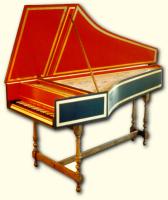


Harpsichord Cello Figured Bass
CONCERTO
A concerto is a piece of music in three movements written for a soloist accompanied by the orchestra. The usual speed of the three movements is -
FAST SLOW FAST
The quick movements were built up in RITORNELLO form. Ritornello means ' little return' and refers to the main theme which was played by the orchestra at the beginning of the movement which was then repeated after each SOLO section. The Ritornello theme may reappear in full or it may be shortened or varied. Its first and last appearances are in the tonic key; at other times it is generally in another key.
Appearances of the ritornello are separated by EPISODES which feature the soloist.
Composers marked each Ritornello section with the word TUTTI, which means 'everyone', and so a plan of a movement in Ritornello form might be written out as
TUTTI: SOLO 1: TUTTI 2: SOLO 2: TUTTI 3: etc.
CONCERTO GROSSO
Concerto grossi were written for a variety of different instruments. The main aim of concerto grossi was to provide opposition and contrast within the music. They were written for the following groups of instruments -
CONCERTINO - which refers to a small group of soloists
RIPIENO - which refers to an orchestra
CONTINUO -as with most Baroque music, a continuo part filled the texture throughout.
Concerto grossi were usually written in three movements -
FAST SLOW FAST
Examples of Concerto Grosso are the Brandenburg Concertos by J.S.Bach and Vivaldi's Four Seasons.
AUTUMN FROM VIVALDI'S FOUR SEASONS
The Four Seasons consists of four solo concertos for violin, string orchestra (ripieno group) and continuo (harpsichord and 'cello). These concertos are programmatic - or descriptive - works, based on poems (possibly by Vivaldi himself) describing the different seasons of the year. Vivaldi breaks up each poem into sections and prints these throughout the score, indicating those points where his music vividly illustrates the ideas mentioned in the poem.
As you listen to the first movement of Autumn, try to spot each return of the ritornello and notice where quotations from the poem occur - and how Vivaldi illustrates these in his music.
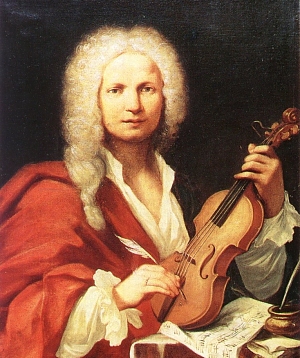 Click
Click ![]() To
Hear the First Movement of Autumn
To
Hear the First Movement of Autumn
Vivaldi
FIRST TWO MOVEMENTS FROM CONCERTO GROSSO IN G MINOR, OP.6, No.6
Each of Handel's twelve Concerti grossi, Opus 6, composed in 1739, are for a concertino group of 2 violins and cello, ripieno strings, and continuo. The second movement is a quick fugue (see later notes).
If you look at the score, you will see how the various instrumental parts are arranged on the page. In the first movement, the two solo violin parts are place above the ripieno violins. The solo 'cello and ripieno 'cellos share the same stave, and the lowest stave is for the double bass and continuo.

Handel
Click ![]() To
Hear the First Movement from this Concerto
To
Hear the First Movement from this Concerto
Click
![]() To
Hear the Second Movement of this Concerto
To
Hear the Second Movement of this Concerto
TEXTURE
The term TEXTURE refers to the number of instruments playing and the way they are playing together. There are three main ways in which a composer may weave the 'fabric' of his music:
1. MONOPHONIC TEXTURE
Monophonic texture is the simplest kind of musical texture. Monophonic texture consists of a single melodic line, without any supporting harmony, though it may be performed by several voices.
2. POLYPHONIC, OR CONTRAPUNTAL TEXTURE
In a polyphonic, or contrapuntal texture (both words have the same meaning) two or more equally important melodic lines weave along at the same time. Quite different melodies may be combined together. The opening of the slow movement of Bach's Brandenburg Concerto No.2 provides a good example.
3. HOMOPHONIC TEXTURE
Texture which is homophonic focuses attention upon a single melody. This kind of texture may be described as 'melody-plus-accompaniment'. The melody is usually at the top of the texture. Most, if not all, the parts move with the same rhythm.
BINARY FORM
There are two simple forms or designs which composers use to shape fairly short pieces of music. One is called BINARY ; the other is called TERNARY.
A piece of music in binary form divides into two sections. Similar to bicycle (two wheels), or binoculars. We call these two sections A and B. Each of them is usually marked with repeat signs.
Here is a Bouree by Handel. It is from the Royal Fireworks Music composed in 1749 for the royal fireworks display in Green Park, London.
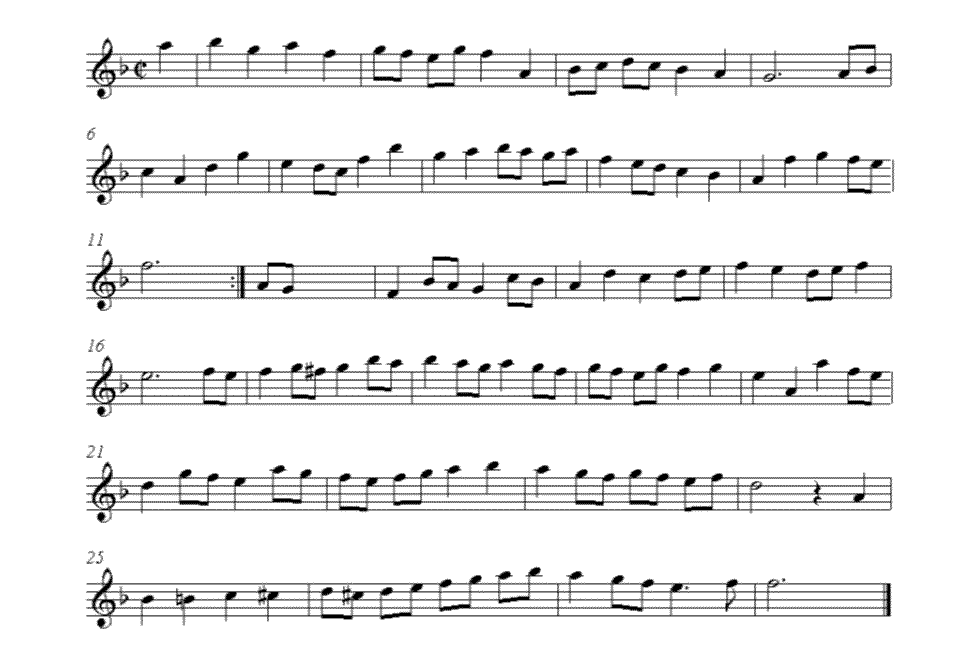
The music clearly divides into two sections. Handel's plan for this piece is:
A (10 BARS) :: (16 BARS)
TERNARY FORM
A piece of music in TERNARY form divides into THREE sections within a single movement.
A B A
Making a kind of musical sandwich. The B section being a contrast to the two outer A sections which are the same music. An example of music in TERNARY FORM is a MINUET AND TRIO
MINUET AND TRIO
The Minuet was a stately French dance of moderate speed with three beats to a bar.
Minuets were often written in pairs - the second minuet being a contrast with the first. To make a longer piece, the two were often performed in TERNARY FORM -
A B A
MINUET 1 MINUET 2 MINUET 1
The second minuet was usually in a new key and as this minuet was often written for three instruments only it became known as a TRIO. Here is the Minuet I and Minuet II from Handel's Music For The Royal Fireworks which make up a minuet and trio -
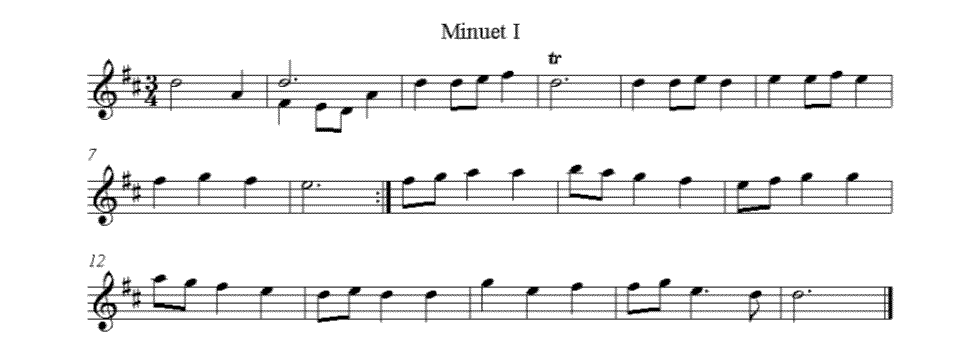
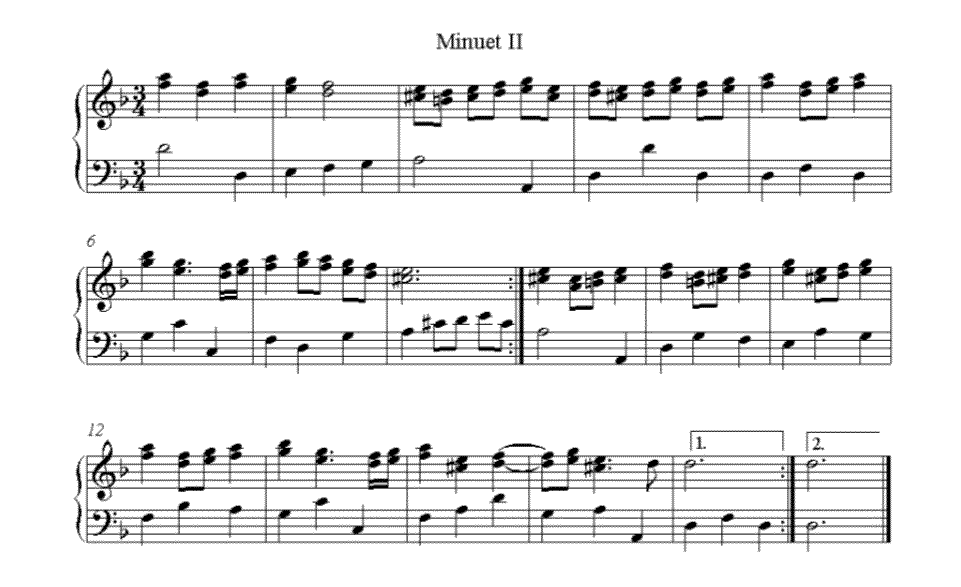
Listen to the above Minuet and Trio from Handel's Music for the Royal Fireworks.
Click ![]() to Hear this Minuet and Trio
to Hear this Minuet and Trio
Click ![]() to return to GCSE Resources page. Click
to return to GCSE Resources page. Click ![]() to go on to Part II of Baroque notes
to go on to Part II of Baroque notes